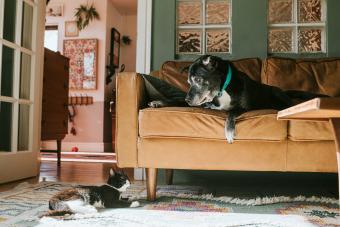
Bringing home a new pet is an exciting milestone, but you may wonder how your current pet will react to their new housemate, and vice versa. Cats and dogs can form very strong friendships, but sometimes, things don't go so smoothly. If you want to increase the odds of everyone getting along, it's best to go slow when introducing a cat to a dog. Gradually get the pets used to each other's smell, give them the opportunity to "greet" each other through a closed door, and finally allow them to meet with supervision. A recent veterinary study also suggests incorporating cat and dog pheromone sprays can help make the introduction a bit smoother. Follow these detailed steps to introduce your cat to your dog so everyone can live in harmony.
Steps to Introduce a Cat to a Dog
Even though you can envision your new cat and dog curled up on the sofa together in snuggly bliss, it may take a bit of time to get to that point. Don't rush the process. Let your pets lead the process, and don't force it. Above all, remain patient and be as calm as possible. Work stepwise using this gradual approach.
1. Make Sure Everyone Is Healthy
Before introducing a cat to a dog, you'll want to have both pets examined by your vet. Even though they're different species, they can still pass diseases or parasites to each other, such as worms, fleas, ringworm, and rabies. Don't let them interact or even share the same areas until they both check out with a clean bill of health.
2. Keep Them Separated
Anytime you bring a new cat home, it's best to keep them confined to a room for a few days. Allowing them to roam the entire house right away can be overwhelming. Place your cat in a spare bedroom or bathroom with their litter box, food, water, bed, and plenty of space to hide. Likewise, if you're bringing home a new dog to greet your established cat, keep the pup confined in a separate room. Dogs aren't quite as sensitive when it comes to new environments, but your cat might not appreciate a new critter invading their space.
Make sure the room has a secure door that isn't at risk of being pushed open by either pet. The cat will ease into their new surroundings while your dog gets accustomed to the fact that there's a new presence in the house. Keep the pets apart for at least three to five days, or until they're both settled.
3. Mix Their Scents
While the pets are separated, they'll smell each other under the door, but you can help move things along by mingling their scents. Every day, swap a pet item from each of the rooms. This works best with soft belongings, such as a towel, blanket, bed, or carrier. The pets will sniff and explore the item as a way to learn about each other. Just be sure to keep an eye out to see if the cat sprays on any dog items; this could mean the dog's presence causes them stress, in which case you'll need to wait a while longer.
4. Let Them "Meet" Through a Closed Door
Food certainly brings people together, and it can work for pets, too. If both pets seem calm and unfazed by the other's scent, try feeding them at the same time on either side of the door. During the meal, they'll smell each other, smell the other's food, and begin to associate the other pet with something positive -- food!
5. Allow the New Pet Out to Explore
While your dog is at daycare or out on a walk with a friend, let your cat out to safely explore the house. This will give your new friend a chance to become familiar with their future home and let them experience more of the dog's smells. You can do a similar swap by placing your cat in a separate room and letting your new dog check out the house.
6. Work on Dog Commands
"Stay," "Come," and "Drop it" are important commands for all dogs to know, but they'll especially come in handy when introducing a cat and dog for the first time. Work on basic obedience with your pup in preparation for their first face-to-face meeting. Make sure you understand their body language so you can read them.

7. Consider Pheromone Sprays
Researchers are always learning more about the cat-dog relationship, and new evidence suggests pheromone sprays could help. You've probably heard of Feliway, a cat-appeasing pheromone used to alleviate stress in cats, but there's a similar pheromone for dogs called Adaptil. Consider purchasing a diffuser of each to plug in near or within a common area where the pets will eventually interact. You can also get spray bottles to spritz as needed. If you can only get one product, choose Adaptil, since the study revealed it has a more significant impact than just Feliway.
8. Initiate a Supervised Meet-and-greet
When both pets are calm and going about their normal business, you can arrange for their first meeting. Plan to do this in a common area away from the new pet's room or any place your resident pet feels particularly comfortable, like their bed or napping area. The common area will serve as neutral ground, so neither feels threatened.
Take your dog for a long walk or hike beforehand, so they're not full of nervous energy. Then, have them on a leash in the common area and instruct them to "Sit" or settle into a comfortable position while you open the door to let kitty enter the space. Calmly sit next to your dog and reward them with treats (as long as they remain calm -- if they freak out or act nervous, do not reward the behavior) while your cat roams the common area. Because they are on leash, you have control and can keep them from frightening the cat with sudden advances or playful movements.
If either pet shows any signs of aggression or fear, like lunging, growling, hissing, swatting, or hiding, separate them immediately. It can be wise to have a familiar friend in the room to help moderate. Make sure you and/or someone you trust is in control at all times for the safety of everyone involved.
9. Reward Positive Behavior
Use positive reinforcement to create a good experience for both the cat and dog. If your dog is constantly being scolded whenever the cat is out, they may associate the new pet with fear and negative experiences. This is just as bad as rewarding their nervous energy with petting or treats.
Instead, reward all good behaviors (and only good behaviors). Give your dog a treat if they stay in a relaxed position while kitty roams. Reward them for being quiet instead of barking with excitement. Praise them for gently sniffing the cat's bottom. Offer your cat the same positive rewards with treats, pets, or soothing praise when they're calm around the dog.
Keep it positive. If your dog reacts negatively, do not acknowledge them with soothing affirmations that everything will be all right. This rewards their negative, nervous energy. Instead, redirect them and reset expectations (perhaps by taking them to another room for a while, or distracting them with a potty trip outside), and wait to positively reward them until they demonstrate the correct behavior you are looking for.
10. Practice, Practice, Practice
It's highly unlikely your cat and dog will become besties after their first introduction. Repeat short daily meetings until they get used to each other. When your dog no longer wants to chase the cat and your cat can confidently walk around the room, you can try allowing them off leash. Always supervise interactions until you feel certain neither pet may hurt the other (even unintentionally).
Introducing a Kitten to a Dog
You'll want to follow the same approach when introducing a kitten to a dog. Some people say this scenario is a little easier because young cats are usually more open to new experiences, like meeting a new friend. There's also a slimmer chance they've had any negative experiences with a dog that could impact how they react to your pup.
Even though kittens are typically less fearful around dogs than adult cats, their small size brings up other challenges. It's possible for an enthusiastic dog to accidentally injure a small kitten when meeting. A spooked kitten could also scratch the dog out of fear, and if you happen to be holding the kitten, they could get you, too.
Things to Keep in Mind
Be mindful of these tips before and when introducing a cat and dog.
- Don't initiate an introduction until you know both pets are settled, calm, and healthy. A stressful situation, like meeting a new animal, can lead to or exacerbate existing health conditions.
- Cats are particularly sensitive to changes. If your cat stops eating, begins hiding, or starts urinating outside the litter box, separate the pets and take your cat to the vet.
- Keep your cat's nails trimmed to avoid any scratches on the dog's eyes or face.
- Make sure you have a cat tree or other high surfaces where your cat can escape if they get overwhelmed.
- Avoid holding one or both of your pets when you introduce them. A pet can unintentionally redirect their fear by scratching or biting you. Not only will this be painful, but cat bites can easily become infected without treatment. Always reach out to your doctor if you sustain a bite.
- Sure, your dog will be interested in your cat, but they'll probably be equally interested in the litter box and cat food, too. Keep the cat food elevated and out of reach. Regularly clean the litter box to prevent your dog from being tempted to eat feces.
- It's OK to ask for help. If you don't seem to be making any progress, don't hesitate to reach out to an animal behaviorist for personalized guidance. Some professionals will even come to your home and work directly with your pets.
How Long Does It Take to Introduce a Cat and Dog?
It's tough to say exactly how long it'll take for your cat and dog to get along, but it can take weeks to months or even years for some pets to tolerate each other. Unfortunately, some cats and dogs may never become friends. Each animal has a unique personality, along with a history that could impact their interactions. But it's important to remember cats and dogs aren't natural enemies, so there's a good chance your two fur children will live peacefully together. Simply go slow, supervise their interactions, and let their bond grow with time.







